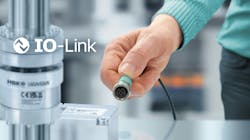Smart Sensors: IO-Link Enables New Era for Strain Gauge Sensors
The digitalization of sensors for mechanical quantities represents the future in modern production and testing technology. Decentralized intelligence, data economy, failure-proof setup and efficient operation all go hand-in-hand with increased accuracy and greatly improved reliability in operation. Smart sensors with an IO-Link interface are set to be the predominant technological solution for sensors in the field-level, providing a future proofed solution that integrates with new and existing machine architectures in an easy, flexible and cost-efficient way.
Machine Design connected with Martin Schütz, product manager, Smart Sensors, Hottinger Brüel & Kjær, to help navigate the interface between smart sensors and IO-Link.
Machine Design: In which applications are strain gauge-based sensors typically used?
Martin Schütz: Strain gauge-based sensors are used in a wide variety of industrial and testing applications and fall into three main categories: force transducers, load cells and torque transducers. Measuring these mechanical quantities (force, load, torque) is at the heart of many mechanical processes in machines and production lines or in end-of-line testing applications. Typical applications are force joining processes; check weighing and torque measurements in end-of-line production; and testing and monitoring applications—just to mention a few.
READ MORE: High-Sensitivity Wide-Range Strain Gauge Mixes Graphene and Silicone-Rubber Matrix
MD: How do smart sensors evolve from the traditional measurement chain?
MS: Traditionally strain-gauge based sensors must be set up in a measurement chain, consisting of a passive sensor, high-quality, double-shielded cabling and an amplifier with the required output signal—that is, analogue (V, mA), serial Bus (Profibus, CAN) or industrial Ethernet (Profinet, Ethernet/IP, EtherCAT, etc.). With the new line of smart sensors, we integrate the sensing element, the amplifier and a microprocessor as well as a communication interface into one single unit.
MD: What are key benefits of integrating electronics into the sensor?
MS: With this approach, we can achieve higher sensor accuracy due to the internal linearization functionality and the possibility of compensating temperature influences on the sensor. With integrated, domain-specific algorithms offering statistical functions such as min/max value tracking, limit switches, a check-weighing algorithm or power calculation, engineers achieve the results needed for their underlying process rather than having to implement these by themselves in the PLC program.
Another groundbreaking advancement is the implementation of a sensor health monitoring feature, which allows the sensors to continuously track the applied load or temperature and compare with the sensor-specific limits. If these limits are overrun, the sensor sends out an alarm event notifying the PLC and higher-level applications about the issue.
MD: Why choose IO-Link as the communication interface?
MS: There are many advantages to the IO-Link interface, and I want to highlight a couple of them. IO-Link unifies the sensor connector and cabling to a single standard allowing for simplification of sensor and actuator setup in the field-level. IO-Link was invented to be integrated into any common fieldbus environment, which is why there are IO-Link masters available for all common industrial Ethernet protocols.
READ MORE: What’s the Difference Between Stress-Strain Curves and Stiffness-Strain Curves?
MD: How does this solution benefit system architects designing state-of-the-art machines and processes?
MS: This is a huge advantage in terms of system design and overall machine architecture because engineers can now design sensor and actuator setups in their machines without having to change a big part of the setup when switching the overarching PLC solution. Furthermore, with IO-Link standardized backup protocols and system setup and parametrization, procedures can be defined for all IO-Link sensors in a machine. This means a huge efficiency benefit in servicing and machine setup.
MD: How is an overall cost-efficiency benefit achieved with this solution?
MS: Overall, the cost efficiency benefits can be divided into three categories. Firstly, due to the higher accuracy of sensors with integrated signal processing, applications benefit from using a single sensor for wider measurement ranges without having to buy multiple sensors with different measurement ranges to fit the application.
READ MORE: Sensors That Promote More Efficient Industrial Workplaces
Secondly, the integrated amplifier and standardized cables and connectors reduce the initial hardware costs. Leveraging the integrated domain-specific algorithms for process control applications such as force limit detection or check weighing also allows for decentralization and means fewer engineering hours in programming these algorithms.
Lastly, the IO-Link protocol standard allows for a standardized sensor setup, which is failsafe, fast and efficient and is the same for all IO-Link sensors. No more different approaches are required—one parametrization solution works for all. This means that less special training is required for system setup and maintenance staff, which results in an overall gain in total cost of ownership (TCO).



